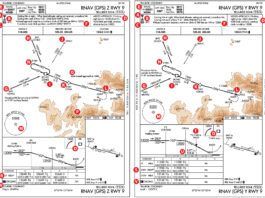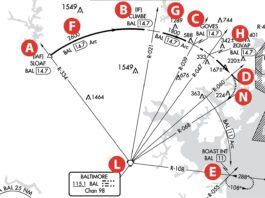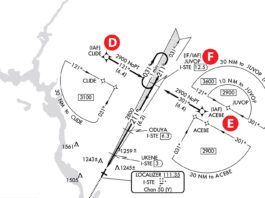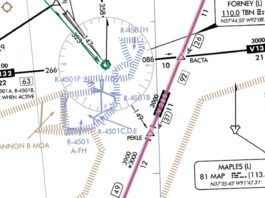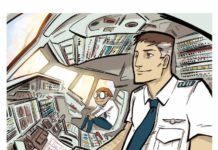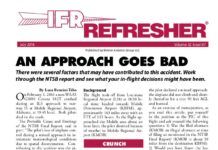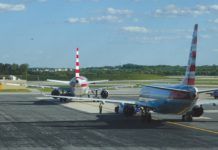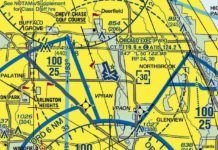Winter Forecasts
Lets start with the basics. In the cool season the North Pole is pointed away from the sun. As the polar regions lose solar heating and the days shorten, the atmosphere cools significantly, and we see a huge semi-permanent polar air mass covering much of Canada and northern Russia. Parts of it break off regularly as frontal systems and polar highs. The large expansion of the cold air mass boots the jet stream out of Canada, pushing it down into the United States.
On The Air: November 2018
One Friday I shot the GPS 7 approach into Gwinnett County, Georgia (KLZU). As I was briefing the approach, I wondered how I would pronounce CURAP, the FAF, if I was asked to report it. Thankfully, that situation did not arise since I was cleared for the approach earlier and sent over to Tower shortly thereafter.
It Did Happen To Me
I installed a G500 on the left-side flight panel. Wanting some real redundancy-not just backup-the limited space on the right panel was perfect for Aspens PFD. This way, if my G500 ever croaked, Id just hop over to the right seat and fly using the Aspen. That also had the advantage of giving any planned right-seater good PFD information should that ever be necessary. I was set.
Briefing: November 2018
Search-and-rescue delays after an airplane crash will become a thing of the past, with Aireons global satellite network in place, the company says. Aireon says the system will be ready to go online in 2019. As long as an aircraft is broadcasting on 1090 MHz ADS-B, we will be able to locate it anywhere worldwide, said Peter Kearney, CEO of the Irish Aviation Authority, one of the partners in the new system. General aviation users dont need to pre-register, but search-and-rescue teams can contact the company for location data. The rescue capability is offered as a free service to the aviation community, Aireon says.
Readback: November 2018
Mr. Bencini-Tibos excellent article, Regulation Fine Points in July might possibly leave the reader thinking that the safety pilot could log time when the flying pilot was not under the hood. FAA Office of Chief Counsel makes it clear in a legal interpretation on this matter dated June 22, 2009 to Jeff Gebhart, that the safety pilot can log only that time that the flying pilot is under the hood. Since the flight is made in an aircraft that does not require a SIC the safety pilot was not a required crew-member during the time the other pilot did not have the hood on, so the safety pilot does not get to log anything during that portion of the flight.
Pilot Shortage?
The normal path for a fledgling airline pilot is to build his/her hours-traditionally as a CFI for pitifully low pay-and get a job with a regional carrier. That new first officer had an average starting pay in the mid-$20/hour range just a few years ago, before the hype of the pilot shortage. Second-year pay jumped nicely, sometimes as much as 50%, but then it stagnated at a few percent a year. A fifth-year first officer might have been making into $40-some/hour.
Briefing: October 2018
This years AirVenture at Oshkosh was about as close as one could imagine to perfect, said EAA chairman Jack Pelton. Attendance set a new record, with about 601,000 visitors, nearly 2 percent more than last years record crowd. Pelton credited the combination of outstanding programs, aircraft variety, a robust economy and good weather, plus the efforts of EAA staff and 5000 volunteers, who created a show that was upbeat and exciting. Planning is already underway for AirVenture 2019, which will run from July 22 to 28. That show will celebrate EAAs 50th consecutive year in Oshkosh.
Readback: October 2018
Many pilots want to fly IFR more often but dont quite remember how. If you addressed more of the basics and less of the quirky and obscure perhaps more pilots would actually benefit. One example would be to have a product published for particular regions or states of the country and present examples each month of airports and approaches for that particular area. This would give the local pilot community more opportunity to fly their local approaches and visit our local airports more often.
Advanced Autopilot Use
Suppose that I am faced with an either-or situation with my autopilot. If I were told I couldnt use the autopilot at either cruise or while being vectored and flying an approach, Id chose to use it on approach. Sure, autopilots help relieve the tedium of long cross-country flights, but they regularly change a stressful approach into a rewarding experience. Lets look at some general tips, then take a close look at how to get the most from your autopilot on approach.
Communication Clarity
How about airplanes already on the ramp? Maybe an airliner advises hes pushing back, but another ones already pushed in his way. Well say, Use caution, Boeing 737 pushed back behind you. Advise ready to taxi. Its both a safety and a time reminder. Watch out for the other guy, and it may be a couple minutes before he can push. Were well aware airlines typically have ramp personnel wing-walking beside them, checking for obstacles. However, stuff happens. Were just covering our bases.
Too Many Approaches
One commenter expressed approval of the cancellation of a circling procedure only if all runways accessible by the procedure have a straight-in IAP with lower minimums than in the canceled procedure. The FAA replied that its policy is not meant to assure straight-in IAPs for every runway end, but rather to minimize redundancy. While cancelling some circling procedures might reduce airport accessibility, runway availability will be unaffected. You might have to fly further to get access to your approach, but its availability will stay the same.
Not Enough Departures
The ATC Handbook, FAA Order 7110.65, Paragraph 4-2-8 directs controllers to ask this of VFR aircraft seeking an IFR clearance in the air until they reach the minimum IFR altitude (MIA), typically, ATCs minimum vectoring altitude or the published MEA. If the pilot is able to maintain terrain and obstruction separation, the Handbook states, issue the appropriate clearance… If unable to maintain terrain and obstruction separation, instruct the pilot to maintain VFR and to state intentions.


